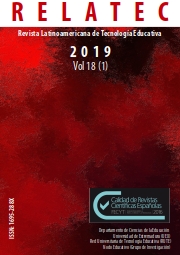Hopscotch 2.0: A tool to promote teachers’ innovative work through the generation of rigorous research designs
DOI:
https://doi.org/10.17398/1695-288X.18.1.23Keywords:
Educational Research, Educational Innovation, Evaluation, Research Tool, Research DesignAbstract
In this article we present Hopscotch 2.0, a theoretical framework and a Webtool developed with the aim of helping novice researchers in the fields of education and social sciences, to generate solid and well-informed research designs. The present work shows the evaluation process of Rayuela 1.0, the obtained formal results, and the changes made to the initial version of Hopscotch that have helped de development of an enhanced 2.O version. Hopscotch is a tool available to teachers interested in the proposal of innovations based on the systematic and rigorous analysis of their practices. The 2.0 offers a web tool for the interactive generation of qualitative, quantitative and mixed method, rigorous and well-informed research designs that allow educators to analyze, criticize and improve their practice. The new improved version of Rayuela is bilingual and offers spaces for the sharing and discussion of the research designs created by its users.
Downloads
References
Booker, S. (2017) Evolution of Pre-Service Teachers TPACK after Completing an Undergraduate Technology Integration Course. Doctoral Dissertation. Kennesaw State University. Recuperado a partir de http://digitalcommons.kennesaw.edu/instruceddoc_etd/5
Breuer, F., & Schreier, M. (2007). Issues in learning about and teaching qualitative research methods and methodology in the social sciences. Forum Qualitative Sozialforschung, 8 (1).
Chumacero-Moscoso, J.L., "El ser y el deber ser de la mujer y del hombre en el cuidado remunerado de ancianos en Segovia." (2018). Master Dissertation. Universidad de Valladolid. http://uvadoc.uva.es/bitstream/10324/30543/1/TFM-B.124.pdf
Daws, A. (2018) Teacher Practices to Help Alternative Education Students. Doctor of Education in Teacher Leadership Dissertations. 26. Recuperado a partir de https://digitalcommons.kennesaw.edu/teachleaddoc_etd/26
Fernández-Faúndez, E.M. (2018). Actitudes del alumnado universitario de España y Argentina hacia la inclusión de alumnado con discapacidad en la Universidad con métodos mixtos según la Teoría de la Conducta Planificada. Doctoral Dissertation. Universidad de Valladolid.
Holmes, T. (2017). Perceptions in a Changing World: Teachers' Attitudes Towards the Implementation of Educational Innovations with a Focus on Social and Emotional Learning. Doctoral Dissertation. Kennesaw State University. Recuperado a partir de https://digitalcommons.kennesaw.edu/teachleaddoc_etd/19
Jones, J. (2017). Perceptions in a Changing World: Teachers' Attitudes Toward the Implementation of Educational Innovations. Doctoral Dissertation. Kennesaw State University. Recuperado a partir de https://digitalcommons.kennesaw.edu/teachleaddoc_etd/18
Jorrín-Abellán, I.M. (2017). Evaluando Rayuela: Una herramienta web para vincular los enfoques paradigmático y pragmático en la enseñanza de métodos de investigación cualitativa. XXV Jornadas Universitarias de Tecnología Educativa (JUTE). Burgos, Spain, June.
Jorrín-Abellán, Iván M. (2016) Hopscotch Building: A Model for the Generation of Qualitative Research Designs, Georgia Educational Researcher, 13(1) DOI: 10.20429/ger.2016.130104.
Lopera Pérez, M. (2017). Experiencia de formación del profesorado basada en el contexto ciudad-escuela. Revista Iberoamericana de Educación, Vol.74:Iss.1, 41-58. Recuperado a partir de https://rieoei.org/RIE/article/view/625
Méndez-Romero, R.A. (2015). El Concepto de Excelencia Docente: Una Aproximación Multidimensional Inductivo-Deductiva desde la Teoría Fundamentada, el Mareo de la Ciencia y el Análisis cualitativo de contenido. Doctoral Dissertation. Universidad de Valladolid. Recuperado a partir de http://uvadoc.uva.es/handle/10324/16236
Myers, Rebecca G., "Transitioning to a Personalized Learning Environment Leveraging One-to-One Devices" (2018). Doctor of Education in Educational Leadership for Learning Dissertations. 14.
Palys, T. (2008). Purposive sampling. In L. M. Given (Ed.) The Sage Encyclopedia of Qualitative Research Methods. (Vol.2). Sage: Los Angeles, pp. 697-8
Prieto-Pariente, J. (2016). La gestión de las actividades de enseñanza aprendizaje bajo el modelo curricular de las competencias básicas en el área de Tecnología. Doctoral Dissertation. Universidad de Valladolid. Recuperado a partir de https://www.educacion.gob.es/teseo/mostrarRef.do?ref=1342479
Ruiz-Calleja, A., Rodríguez-Triana, M. J., Prieto, L. P., Poom-Valickis, K., Ley, T. (2017). Towards a Living Lab to Support Evidence-based Educational Research and Innovation. Proceedings of the Learning Analytics Summer Institute Spain 2017: Advances in Learning Analytics, 1925: Learning Analytics Summer Institute Spain: Advances in Learning Analytics; Spain; 4-5 July 2017. 31−38.
Tracy, S. (2010). Qualitative quality: Eight a"big-tent" criteria for excellent qualitative research. Qualitative Inquiry, 16(10), 837-851. doi:10.1177/1077800410383121
Vitala, A. E. (2016) From #edcamp to #edchat: A Case Study Exploring Innovative, Self-Directed Educator Professional Learning. Doctoral Dissertation. Kennesaw State University. Recuperado a partir de https://digitalcommons.kennesaw.edu/teachleaddoc_etd/13
Downloads
Published
Issue
Section
License
Authors who publish in this journal accept the following conditions:
1. The Author retains copyright in the article. Upon acceptance of the article, the author shall grant to the Publisher the right of first publication of the article. with the dcoument registered with the Creative Commons Attribution-NonCommercial-NoDerivative 4.0 International (CC BY-NC-ND) license, which allows to third parties to use what is published whenever they mention the authorship of the work and the first publication in this journal.
2. Authors can make other independent and additional contractual agreements for the non-exclusive distribution of the article published in this journal (eg, include it in an institutional repository or publish it in a book) provided they clearly indicate that the work was published for the first time in this journal.
3. Authors are allowed and recommended to publish their work on the Internet (for example on institutional or personal pages) before and during the review and publication process, as it can lead to productive exchanges and a greater and faster diffusion of published work (see The Effect of Open Access).









